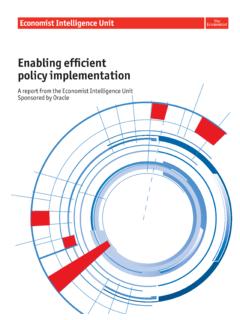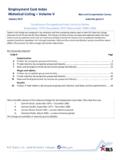Transcription of South Africa: WHO and UNICEF estimates of immunization ...
1 South Africa: WHO and UNICEF estimates of immunization coverage: 2019 revisionJuly 6, 2020; page 1 WHO and UNICEF estimates of national immunization coverage - next revision available July 15, 2021data received as of June 29, 2020 South Africa: WHO and UNICEF estimates of immunization coverage: 2019 revisionBACKGROUND NOTE: Each year WHO and UNICEF jointly review reports submitted by MemberStates regarding national immunization coverage, finalized survey reports as well as data from thepublished and grey literature. Based on these data, with due consideration to potential biases and theviews of local experts, WHO and UNICEF attempt to distinguish between situations where theavailable empirical data accurately reflect immunization system performance and those where the dataare likely to be compromised and present a misleading view of immunization coverage while jointlyestimating the most likely coverage levels for each and UNICEF estimates are country-specific; that is to say, each country s data are reviewedindividually, and data are not borrowed from other countries in the absence of data.
2 estimates are notbased on ad hoc adjustments to reported data; in some instances empirical data are available from asingle source, usually the nationally reported coverage data. In cases where no data are available for agiven country/vaccine/year combination, data are considered from earlier and later years andinterpolated to estimate coverage for the missing year(s). In cases where data sources are mixed andshow large variation, an attempt is made to identify the most likely estimate with consideration of thepossible biases in available data. For methods see:*Burton et al. 2009 . WHO and UNICEF estimates of national infant immunization coverage: methodsand processes.*Burton et al. 2012. A formal representation of the WHO and UNICEF estimates of nationalimmunization coverage: a computational logic approach.*Brown et al. 2013. An introduction to the grade of confidence used to characterize uncertainty aroundthe WHO and UNICEF estimates of national immunization coverage:Reported by national authorities and based on aggregatedadministrative reports from health service providers on the number of vaccinations administeredduring a given period (numerator data) and reported target population data (denominator data).
3 May be biased by inaccurate numerator and/or denominator coverage:Estimated coverage reported by national authorities that reflects theirassessment of the most likely coverage based on any combination of administrative coverage,survey-based estimates or other data sources or adjustments. Approaches to determineOFFICIAL coverage may differ across coverage:Based on estimated coverage from population-based household surveys amongchildren aged 12-23 months or 24-35 months following a review of survey methods and is based on the combination of vaccination history from documented evidence orcaregiver recall. Survey results are considered for the appropriate birth cohort based on theperiod of data :percentage of births who received one dose of Bacillus Calmette Guerin / DTP3:percentage of surviving infants who received the 1st / 3rd dose, respectively, ofdiphtheria and tetanus toxoid with pertussis containing :percentage of surviving infants who received the 3rd dose of polio containing vaccine.
4 May beeither oral or inactivated polio :percentage of surviving infants who received at least one dose of inactivated polio vaccine. Incountries utilizing an immunization schedule recommending either (i) a primary series of threedoses of oral polio vaccine (OPV) plus at least one dose of IPV where OPV is included in routineimmunization and/or campaign or (ii) a sequential schedule of IPV followed by OPV, WHO andUNICEF estimates for IPV1 reflect coverage with at least one routine dose of IPV among infants<1 year of age among countries. For countries utilizing IPV containing vaccine use only, , norecommended dose of OPV, the WHO and UNICEF estimate for IPV1 corresponds to coveragefor the 1st dose of of IPV coverage estimates , which begins in 2015, results in no change of theestimated coverage levels for the 3rd dose of polio (Pol3). For countries recommending routineimmunization with a primary series of three doses of IPV alone, WHO and UNICEF estimatedPol3 coverage is equivalent to estimated coverage with three doses of IPV.
5 For countries with asequential schedule, estimated Pol3 coverage is based on that for the 3rd dose of polio vaccineregardless of vaccine :percentage of surviving infants who received the 1st dose of measles containing vaccine. Incountries where the national schedule recommends the 1st dose of MCV at 12 months or laterbased on the epidemiology of disease in the country, coverage estimates reflect the percentage ofchildren who received the 1st dose of MCV as :percentage of children who received the 2nd dose of measles containing vaccine according tothe nationally recommended :percentage of surviving infants who received the 1st dose of rubella containing vaccine. Coverage estimates are based on WHO and UNICEF estimates of coverage for the dose of measlescontaining vaccine that corresponds to the first measles-rubella combination vaccine. Nationallyreported coverage of RCV is not taken into consideration nor are the data represented in theaccompanying graph and data :percentage of births which received a dose of hepatitis B vaccine within 24 hours of of hepatitis B birth dose coverage are produced only for countries with a universalbirth dose policy.
6 estimates are not produced for countries that recommend a birth dose toinfants born to HepB virus-infected mothers only or where there is insufficient information todetermine whether vaccination is within 24 hours of :percentage of surviving infants who received the 3rd dose of hepatitis B containing vaccinefollowing the birth :percentage of surviving infants who received the 3rd dose of Haemophilus influenzae type bcontaining :percentage of surviving infants who received the final recommended dose of rotavirus vaccine,which can be either the 2nd or the 3rd dose depending on the :percentage of surviving infants who received the 3rd dose of pneumococcal conjugate countries where the national schedule recommends two doses during infancy and a boosterdose at 12 months or later based on the epidemiology of disease in the country, coverageestimates may reflect the percentage of surviving infants who received two doses of PcV prior tothe 1st :percentage of surviving infants who received one dose of yellow fever vaccine in countries whereYFV is part of the national immunization schedule for children or is recommended in at riskareas; coverage estimates are annualized for the entire cohort of surviving : All reasonable precautions have been taken by the World Health Organization andUnited Nations Children s Fund to verify the information contained in this publication.
7 However,the published material is being distributed without warranty of any kind, either expressed orimplied. The responsibility for the interpretation and use of the material lies with the reader. Inno event shall the World Health Organization or United Nations Children s Fund be liable fordamages arising from its 6, 2020; page 2 WHO and UNICEF estimates of national immunization coverage - next revision available July 15, 2021data received as of June 29, 2020 South Africa - BCG2008200920102011201220132014201520162 01720182019 Estimate848281848688938390757084 Estimate GoC Official938986888989938390757084 Administrative938986888989938390747184 SurveyNANANANANANA9292 NANANANAThe WHO and UNICEF estimates of national immunization coverage (wuenic) are based on data and informationthat are of varying, and, in some instances, unknown quality. Beginning with the 2011 revision we describethe grade of confidence (GoC) we have in these estimates .
8 As there is no underlying probability model uponwhich the estimates are based, we are unable to present classical measures of uncertainty, , confidenceintervals. Moreover, we have chosen not to make subjective estimates of plausibility/certainty ranges aroundthe coverage. The GoC reflects the degree of empirical support upon which the estimates are based. It isnot a judgment of the quality of data reported by national authorities. Estimate is supported by reported data [R+], coverage recalculated with an independent denominatorfrom the World Population Prospects: 2019 revision from the UN Population Division (D+), and atleast one supporting survey within 2 years [S+]. While well supported, the estimate still carries a riskof being wrong. Estimate is supported by at least one data source; [R+], [S+], or [D+]; and no data source, [R-], [D-], or[S-], challenges the estimate.
9 There are no directly supporting data; or data from at least one source; [R-], [D-], [S-]; challenge the all cases these estimates should be used with caution and should be assessed in lightof the objective for which they are being :2019: Estimate based on coverage reported by national government. Reported data suggestsincrease in doses administered, in spite of one month national vaccine stock-out, andrecovery from prior year supply disruption. GoC=R+ D+2018: Estimate based on coverage reported by national government. Programme reports threemonth vaccine stock-out at national level. GoC=R+ D+2017: Estimate based on coverage reported by national government. Decline in reported cover-age unexplained. Estimate follows trend in reported data consistent with other challenged by: S-2016: Estimate based on coverage reported by national government.
10 Estimate challenged by:D-2015: Estimate based on coverage reported by national government supported by survey. Surveyevidence of 92 percent based on 1 survey(s). Programme reports three month nationallevel stock-out. Estimate challenged by: D-2014: Estimate based on coverage reported by national government supported by survey. Sur-vey evidence of 92 percent based on 1 survey(s). Unexplained decline in reported targetpopulation for 2014 compared to 2013 following substantial increase in target populationbetween 2012 and 2013. WHO and UNICEF encourage a revision of the reported cov-erage time series using updated population estimates following the release of the recentcensus. Estimate challenged by: D-2013: Reported data calibrated to 2003 and 2014 levels. Decreases in coverage may reflect useof revised target population estimates . Estimate challenged by: R-2012: Reported data calibrated to 2003 and 2014 levels.
















